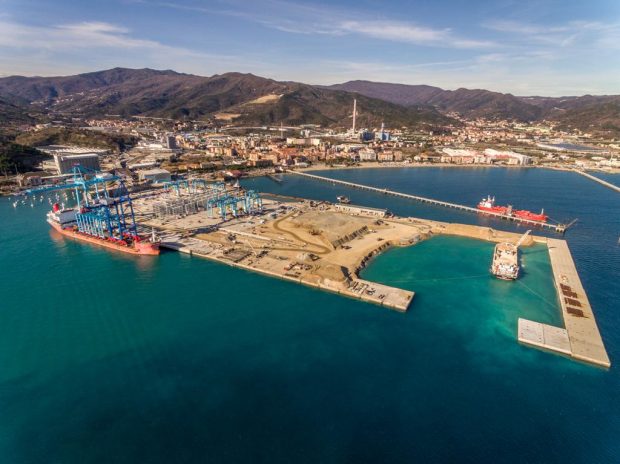
China contributes to Italian port construction for win-win results

Chinese company COSCO SHIPPING Ports Limited is contributing efforts to the construction of an Italian port, lifting capacity for the terminal and creating win-win results, as China’s Belt and Road Initiative (BRI) continues expanding its global influence.
The Port of Vado Ligure, 140 kilometers away from Italy’s industrial powerhouse Turin and 190 kilometers away from Milan, enjoys ideal geographical location. It is of vital importance for the economic development of northern Italy. In October 2016, the COSCO SHIPPING Ports Limited officially joined the construction and operation of a new container terminal at the Port of Vado Ligure, after reaching an agreement with Vado Holding B.V. The terminal, upon completion, will become Italy’s first automated container terminal, and also the first one built in the recent three decades in the country.
Currently, the construction of the container terminal is in full swing. Gantry cranes and quay cranes have been installed and started operation, and the bridge cranes are also ready for use. Site manager of Vado Holding Bruno told People’s Daily that nearly 80 percent of the project had been completed, and the first berth is expected to be put into use before the end of this year. “The new terminal will have a quay that is 700 meters long, with an annual handling capacity of 860,000 TEUs,” Bruno said, adding that it can berth the largest vessel in the world.
According to Wang Yuqiu, vice-general manager of Vado Holding, the maximum capacity of surrounding terminals was 8,800 TEUs due to the limited channel depth and headroom. He introduced that the new terminal would be able to berth 20,000-TEU vessels, expanding the original cargo structure of the port that used to center with fruits. With the inflow of other commodities such as industrial products and daily necessities, the cargo supply structure of the port will be largely diversified, Wang added.
After inspecting at the construction site, Vado Holding’s general manager Paolo Cornetto received an interview from People’s Daily. He said that the advanced equipment and operation system brought by the Chinese enterprise offered powerful technical support for the Italian side to construct its first automated container terminal. The new terminal would create nearly 400 jobs for local community, he added. Since the start of the China-Italy cooperation, the operation of the Vado Holding witnessed continuous improvement. Last year, the company’s profit went up by 16 percent. Cornetto was very pleased to see the new development of the company, saying the Chinese management team shared valuable experiences in construction and operation. “We have the same goal, and the cooperation is energetic. Everyone is actively facing challenges and focusing on their jobs,” he said. “In a sense, the cooperation between China and Italy on the construction of the Vado port is collaboration between the strong, and our clients are also expecting the cooperation to bring new changes to the port,” Cornetto told People’s Daily.
“The BRI enhanced connectivity among countries along the route, and facilitated social and economic development,” said Cornetto, believing that the Vado port would play a more important role in the initiative. Paolo Emilio Signorini, president of the Port Authority of the Port of Genoa, noted that Chinese investment endowed the Vado Ligure port with a new look. Thanks to the COSCO fleet, more and more cargos were entering the port, which further facilitated the development of local logistics industry, created more jobs, and injected impetus to the economy of Genoa, he said. “The construction of the Vado Ligure port is an important part to improve the supply chain in northern Italy, Switzerland and southern Germany, and the port will possess a vital strategic position in the Liguria region, greatly improving the efficiency of the terminals.” said Giovanni Toti, president of Liguria. “We hope to make more contributions to the construction of the Belt and Road,” he told People’s Daily.
In the future, most of the cargos imported via the Vado Ligure port will be transported by rail to northern Italy, Germany and Switzerland. “I hope that the port can be connected with the China-Europe freight trains so that the cargos imported via the port can be shipped to central and western Europe, central Asia and China by land. In addition, the cargos transported by the freight service can also be transferred to the port and be shipped to Algeria, Tunisia and Morocco,” Wang told People’s Daily. If so, the Vado Ligure port will not only serve as a new gate for central and southern Europe, but also a channel to enhance the region’s trade relations with Africa. Apart from the Vado Ligure container terminal, other ports in Trieste on the Adriatic Sea, in Venice and Ravenna are also beefing up cooperation with Chinese enterprises.
Italy issued its fifth annual report on blue economy last June, pointing out that the transportation route of Asian trade was gradually becoming a leading force for global trade under the promotion of the Belt and Road construction. The competitiveness of the Mediterranean ports was rising together with their elevating importance, the report said.
By Ye Qi and Han Shuo
(People’s Daily)


